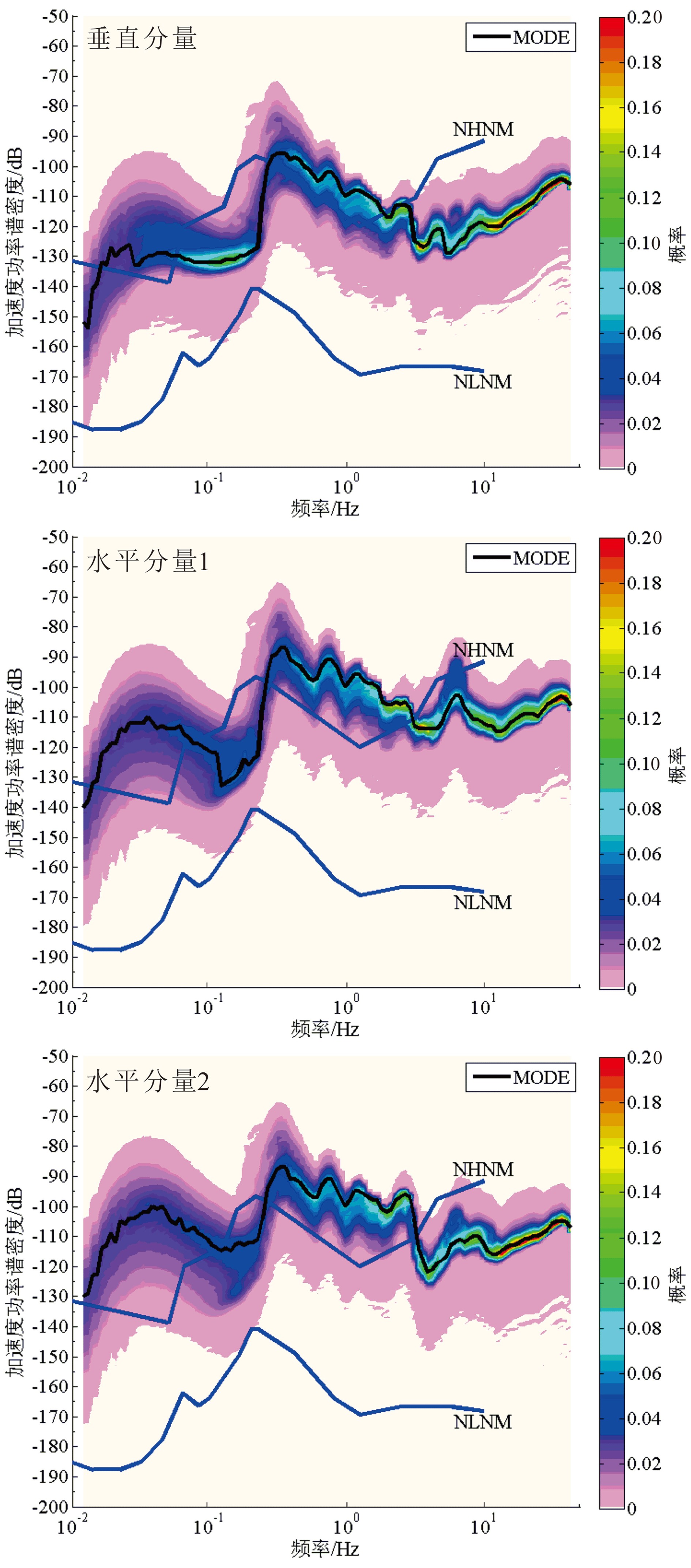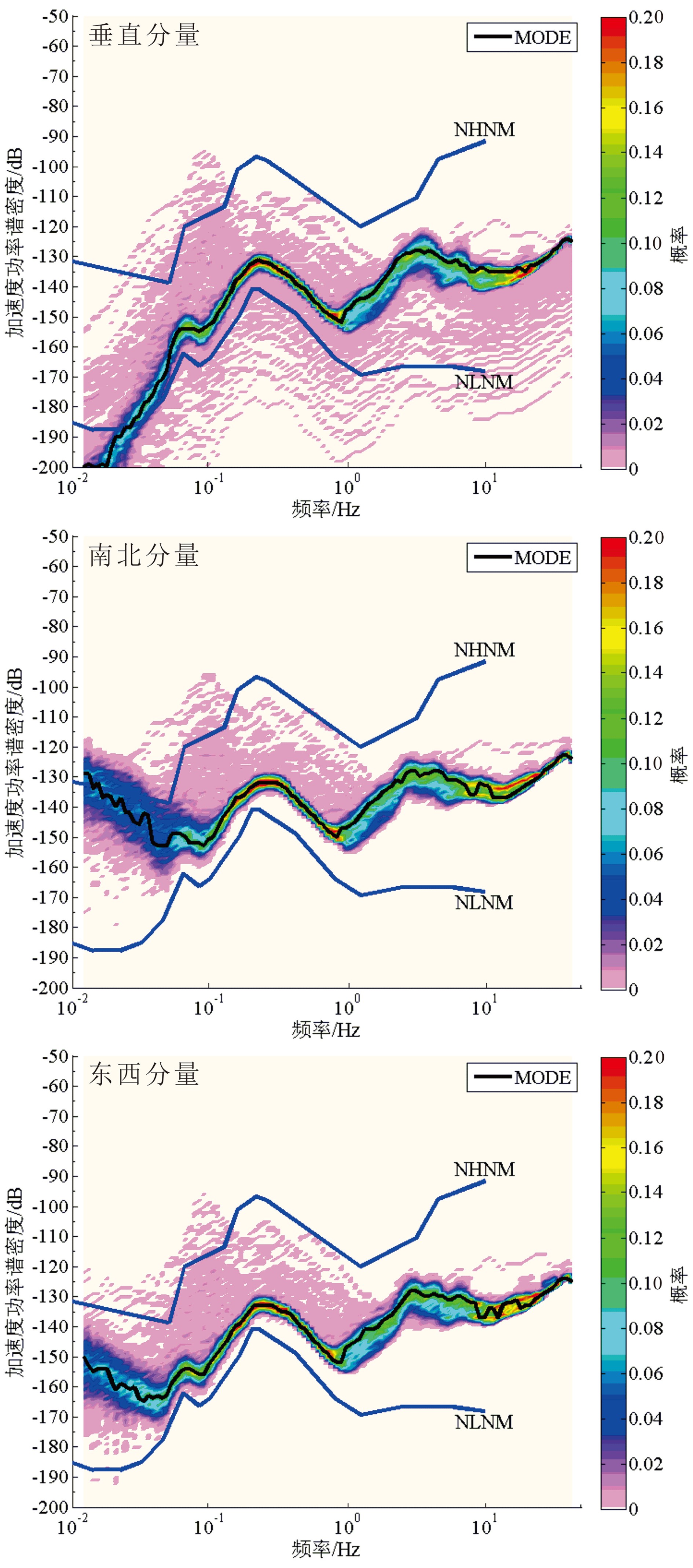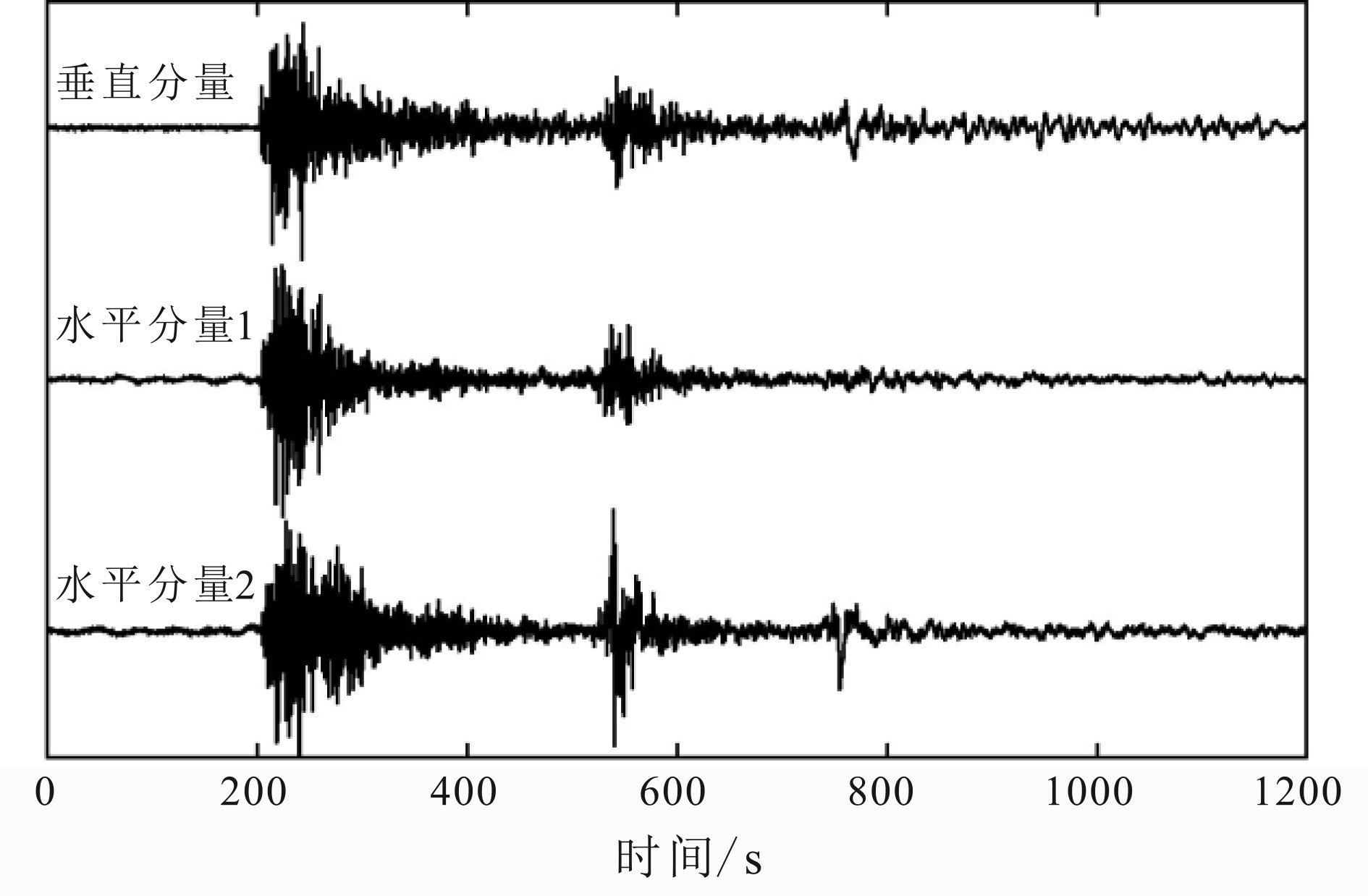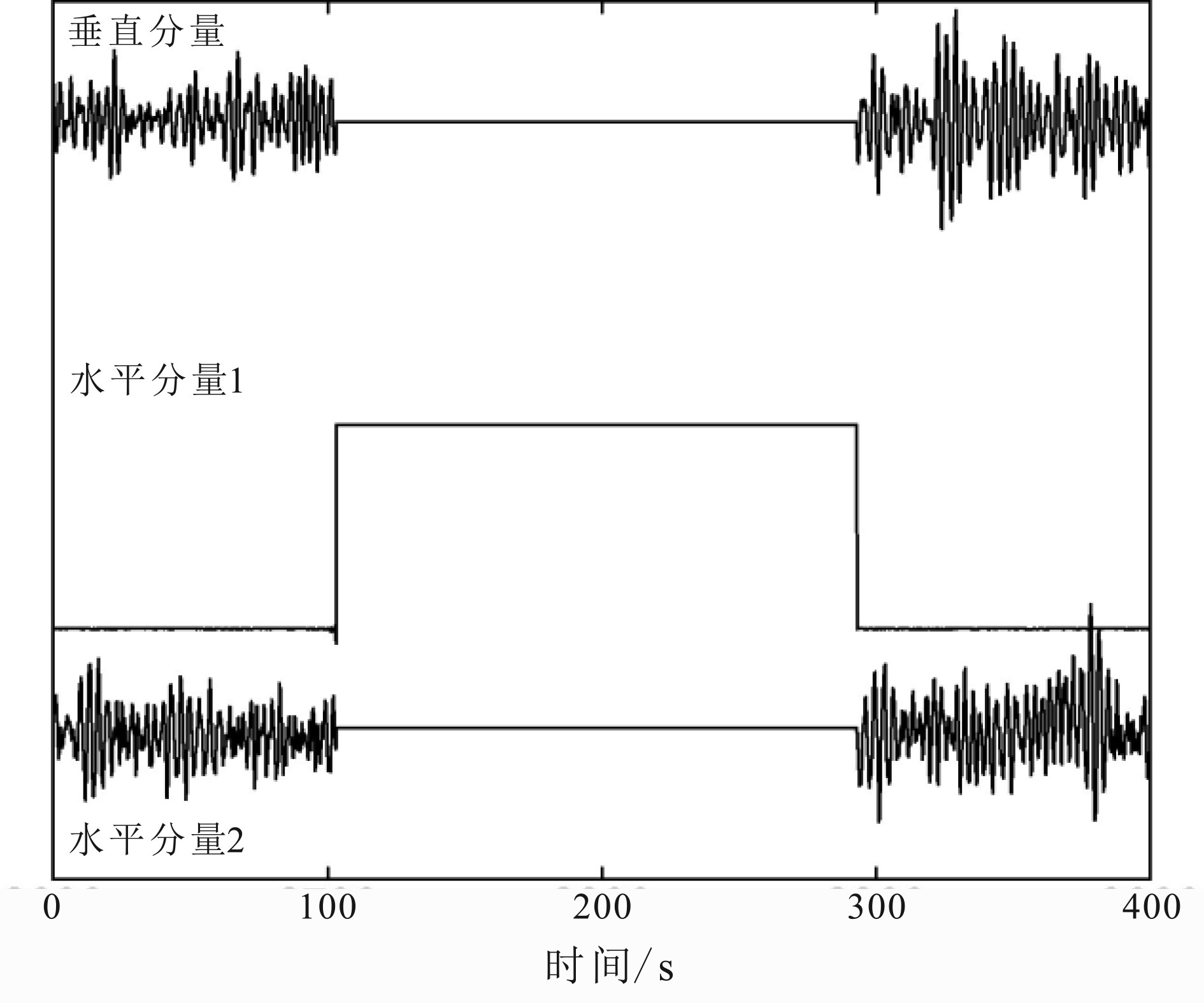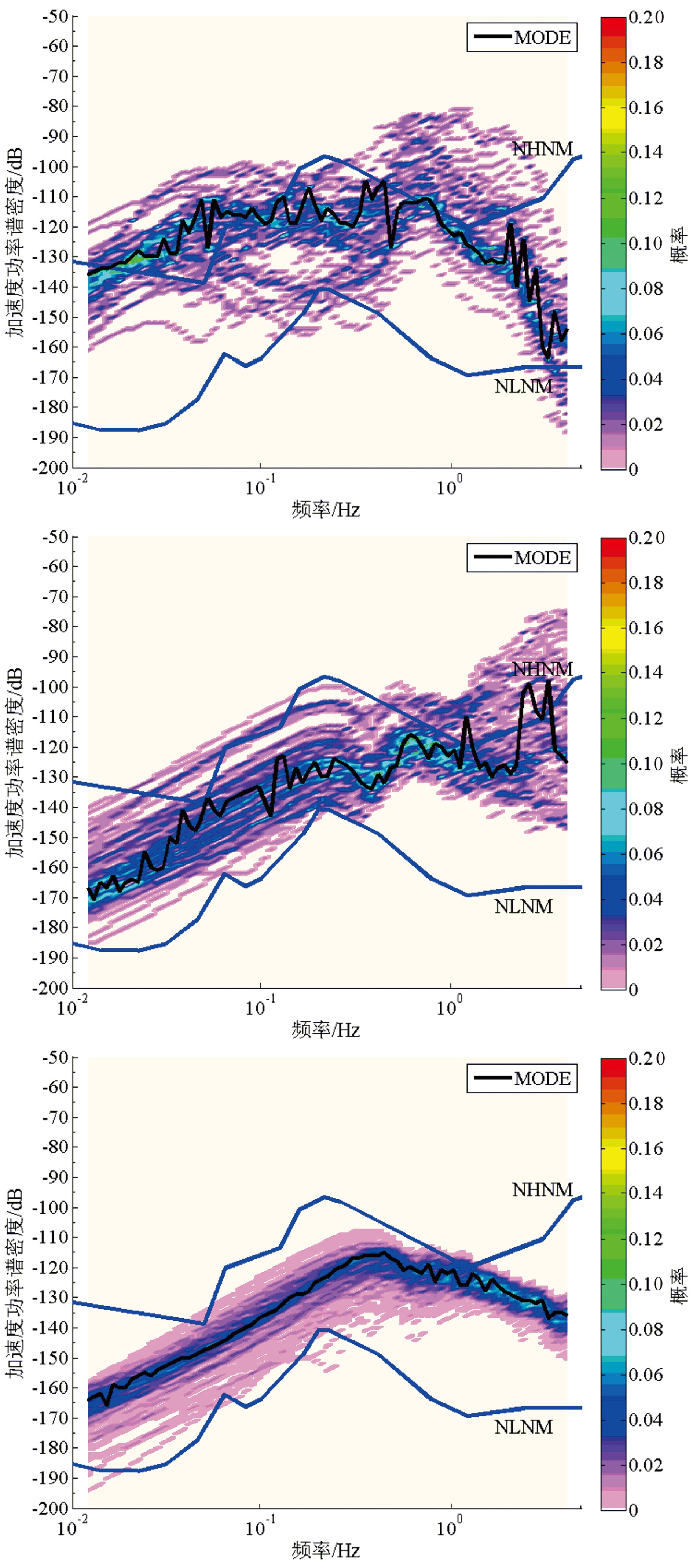Research on seismic background noise in the Eastern Subbasin of the South China Sea
-
摘要:
背景噪声的强弱是影响地震台站观测的一个重要因素。获取背景噪声的分布特征对评估海底地震仪记录数据质量及对数据的降噪处理均具有重要的指示意义。利用概率密度函数方法获取台站数据的功率谱密度的概率分布特征并与全球背景噪声高值模型和低值模型进行对比是研究台站周围环境背景噪声水平的有利手段。本研究基于南海大规模的被动源海底地震仪台阵长期观测实验的部分数据,利用概率密度函数方法研究了南海的背景噪声。首先,在全频段上对背景噪声进行了分析,并与其他台站做了对比,发现海洋的背景噪声在微震段和低频段大于高值模型且在全频带上远大于陆基台站的背景噪声,这表明海底地震仪数据质量并不高;其次,对观测过程中出现的地震事件以及其他典型信号的概率密度分布进行了归纳总结,发现远震事件、近震事件和数据丢失现象分别具有不同的优势频段和特征,这对后续滤波处理和质量检查具有重要指示意义;最后,研究了背景噪声的时间变化特征,发现台风是导致微震段时间变化的主要原因。
Abstract:The intensity of background noise is an important factor that affects the observation of seismic stations. Acquiring the characteristics of the background noise is of great significance to the evaluation of the quality of the data recorded by the Ocean Bottom Seismometer (OBS) and the noise reduction of the recorded data. Using the Probability Density Function (PDF) method to obtain the probability distribution characteristics of the Power Spectral Density (PSD) of the recorded data and comparing them with the results of new high-noise model (NHNM) and new low-noise model (NLNM) is a favorable method to research the background noise level around the station. Based on the long-term observation data of a large-scale passive source OBS array in the South China Sea (SCS), the background noise in the SCS is studied by using the PDF method. Firstly, the background noise in the whole frequency band is analyzed and compared with that from other stations. It is found that the background noise in the ocean is greater than the NHNM in the microseisms and low frequency band, and far greater than the background noise of the land-based station in the whole frequency band, which indicates that the data quality of the OBS is poor. Secondly, the probability density distribution of the earthquakes and other signals in the observation process is summarized, and it is found that the teleseismic, near earthquake and data dropout signal have different dominant frequency bands respectively, which has important significance for subsequent filtering processing and quality inspection. Finally, the time variation characteristics of background noise are studied, and it is found that typhoon is the main cause of time variation in microseisms period.
-

-
表 1 南海东部次海盆台站布放资料
Table 1. The deployment data of OBS
台站编号 东经 北纬 水深/m 台站型号 HY15 117°32′ 16°30′ 3753 Guralp CMG-40T HY16 118°12′ 16°27′ 3920 Guralp CMG-40T HY17 118°48′ 16°12′ 3870 Guralp CMG-40T -
[1] Agnew D C, Berger J. Vertical seismic noise at very low frequencies [J]. Journal of Geophysical Research, 1978, 83(B11): 5420-5424. doi: 10.1029/JB083iB11p05420
[2] Berger J, Davis P, Ekström G. Ambient Earth noise: A survey of the global seismographic network [J]. Journal of Geophysical Research, 2004, 109: B11307. doi: 10.1029/2004JB003408
[3] Webb S C. Broadband seismology and noise under the ocean [J]. Reviews of Geophysics, 1998, 36(1): 105-142. doi: 10.1029/97RG02287
[4] Peterson J. Observations and modeling of seismic background noise[R]. U.S. Geological Survey Open File Report, 1993: 93-322.
[5] McNamara D E, Buland R P. Ambient noise levels in the Continental United States [J]. Bulletin of the Seismological Society of America, 2004, 94(4): 1517-1527. doi: 10.1785/012003001
[6] 吴建平, 欧阳飚, 王未来, 等. 华北地区地震环境噪声特征研究[J]. 地震学报, 2012, 34(6):818-829
WU Jianping, OUYANG Biao, WANG Weilai, et al. Ambient noise level of North China from temporary seismic array [J]. Acta Seismologica Sinica, 2012, 34(6): 818-829.
[7] 葛洪魁, 陈海潮, 欧阳飚, 等. 流动地震观测背景噪声的台基响应[J]. 地球物理学报, 2013, 56(3):857-868
GE Hongkui, CHEN Haichao, OUYANG Biao, et al. Transportable seismometer response to seismic noise in vault [J]. Chinese Journal of Geophysics, 2013, 56(3): 857-868.
[8] 林彬华, 金星, 李军, 等. 台网噪声评估及其对气枪震源激发效果影响的研究[J]. 地震学报, 2017, 39(3):330-342, 451
LIN Binhua, JIN Xing, LI Jun, et al. Station network ambient noise level evaluation and its influence on air gun source excitation effect [J]. Acta Seismologica Sinica, 2017, 39(3): 330-342, 451.
[9] 刘旭宙, 沈旭章, 张元生, 等. 基于噪声概率密度函数的地震计观测性能对比[J]. 地震学报, 2018, 40(4):461-470
LIU Xuzhou, SHEN Xuzhang, ZHANG Yuansheng, et al. Comparison on different seismometers performance based on probability density functions [J]. Acta Seismologica Sinica, 2018, 40(4): 461-470.
[10] Li C F, et al. Opening of the South China Sea and its implications for Southeast Asian tectonics since the late Mesozoic[R]. IODP Proposal, 2008.
[11] Li C F, Li J B, Ding W W, et al. Seismic stratigraphy of the central South China Sea basin and implications for neotectonics [J]. Journal of Geophysical Research: Solid Earth, 2015, 120(3): 1377-1399. doi: 10.1002/2014JB011686
[12] Li C F, Xu X, Lin J, et al. Ages and magnetic structures of the South China Sea constrained by deep tow magnetic surveys and IODP expedition 349 [J]. Geochemistry, Geophysics, Geosystems, 2014, 15(12): 4958-4983. doi: 10.1002/2014GC005567
[13] Zhao M H, He E Y, Sibuet J C, et al. Postseafloor spreading volcanism in the central East South China Sea and its formation through an extremely thin oceanic crust [J]. Geochemistry, Geophysics, Geosystems, 2018, 19(3): 621-641. doi: 10.1002/2017GC007034
[14] Lei J S, Zhao D P, Steinberger B, et al. New seismic constraints on the upper mantle structure of the Hainan plume [J]. Physics of the Earth and Planetary Interiors, 2009, 173(1-2): 33-50. doi: 10.1016/j.pepi.2008.10.013
[15] Xia S H, Zhao D P, Sun J L, et al. Teleseismic imaging of the mantle beneath southernmost China: New insights into the Hainan plume [J]. Gondwana Research, 2016, 36: 46-56. doi: 10.1016/j.gr.2016.05.003
[16] Liu C G, Hua Q F, Pei Y L, et al. Passive-source ocean bottom seismograph (OBS) array experiment in South China Sea and data quality analyses [J]. Chinese Science Bulletin, 2014, 59(33): 4524-4535. doi: 10.1007/s11434-014-0369-4
[17] Laske G, Collins J A, Wolfe C J, et al. Probing the Hawaiian hot spot with new broadband ocean bottom instruments [J]. EOS Transactions American Geophysical Union, 2009, 90(41): 362-363. doi: 10.1029/2009EO410002
[18] Toomey D R, Allen R M, Barclay A H, et al. The Cascadia initiative: A sea change in seismological studies of subduction zones [J]. Oceanography, 2014, 27(2): 138-150. doi: 10.5670/oceanog.2014.49
[19] Stähler S C, Sigloch K, Hosseini K, et al. Performance report of the RHUM-RUM ocean bottom seismometer network around La Reunion, western Indian Ocean [J]. Advances in Geosciences, 2016, 41: 43-63. doi: 10.5194/adgeo-41-43-2016
[20] Xiao H, Xue M, Yang T, et al. The characteristics of microseisms in South China Sea: results from a combined data set of OBSs, broadband land seismic stations, and a global wave height model [J]. Journal of Geophysical Research: Solid Earth, 2018, 123(5): 3923-3942. doi: 10.1029/2017JB015291
[21] Collins J A, Vernon F L, Orcutt J A, et al. Broadband seismology in the oceans: Lessons from the ocean seismic network pilot experiment [J]. Journal of Geophysical Research, 2001, 28(1): 49-52. doi: 10.1029/2000GL011638
[22] Crawford W C, Webb S C. Identifying and removing tilt noise from low-frequency (<0.1 Hz) seafloor vertical seismic data [J]. Bulletin of the Seismological Society of America, 2000, 90(4): 952-963. doi: 10.1785/0119990121
[23] Dahm T, Tilmann F, Morgan J P. Seismic broadband ocean-bottom data and noise observed with free-fall stations: Experiences from long-term deployments in the North Atlantic and the Tyrrhenian Sea [J]. Bulletin of the Seismological Society of America, 2006, 96(2): 647-664. doi: 10.1785/0120040064
[24] Araki E, Shinohara M, Sacks S, et al. Improvement of seismic observation in the ocean by use of seafloor boreholes [J]. Bulletin of the Seismological Society of America, 2004, 94(2): 678-690. doi: 10.1785/0120020088
[25] Longuet-Higgins M S. A theory of the origin of microseisms [J]. Philosophical Transactions of the Royal Society A: Mathematical, Physical and Engineering Sciences, 1950, 243(857): 1-35.
[26] Stephen R A, Spiess F N, Collins J A, et al. Ocean seismic network pilot experiment [J]. Geochemistry, Geophysics, Geosystems, 2003, 4: 1092. doi: 10.1029/2002GC000485
[27] Bromirski P D, Duennebier F K, Stephen R A. Mid-ocean microseisms [J]. Geochemistry, Geophysics, Geosystems, 2005, 6: Q04009. doi: 10.1029/2004GC000768
[28] Stutzman E, Roult G, Astiz L. Geoscope station noise levels [J]. Bulletin of the Seismological Society of America, 2000, 90(3): 690-701. doi: 10.1785/0119990025
-




 下载:
下载:
